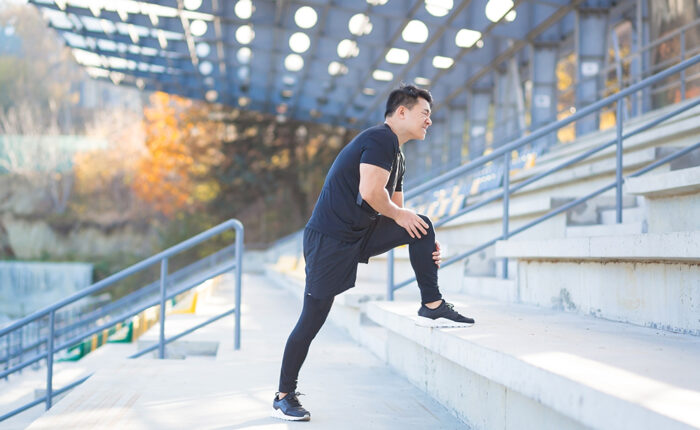Muscle strains can be painful and frustrating. You want to get back to your normal routine, but your muscles aren’t quite ready yet. Recovering full strength and range of motion can take time, and physical therapy can help.
The timeline for your recovery is based on a lot of factors, and some of these depend on your routine. This means there are steps you can follow to speed up muscle strain recovery. With these tips in mind, you can ensure a return to previous activity levels as soon as possible.
Tip 1: Rest
The first step in recovery, and among the most important, is rest. Giving your strained muscle time to rest at first is how you can speed up recovery later on. Avoid painful or uncomfortable activities, and focus on getting plenty of sleep. After a strain, your muscle is at its most vulnerable, so resting is a good way to prevent further injury. Rest speeds up muscle strain recovery by allowing your body to properly heal and avoid future setbacks.
Tip 2: Manage pain
Medication, targeted exercise, and supportive braces or other wearables can all reduce any pain you feel from your muscle strain. If your pain is intense enough to require prescription medication, your doctor can help you decide on the best option to suit your treatment needs.
Exercise can be a more appealing option for people with lower levels of pain, as it promotes health while also alleviating pain. If pain continues to be a big problem for you, a pain management specialist can help find better solutions. While pain management strategies may not directly speed up your muscle strain recovery, they can reduce discomfort and make everything else easier.
Tip 3: Ice the muscle
Applying ice to a strained muscle at home can reduce pain and swelling. Wrapping an ice pack in a towel and applying it for only 15 to 20 minutes at a time can reduce swelling quickly. Persistence is key, as this should be done several times a day for at least the first two or three days after injury.
If you continue to experience pain and swelling, you may want to continue icing the muscle to reduce the risk of further swelling. This is one way you can speed up muscle strain recovery, because reducing swelling tends to speed up muscle healing.
Tip 4: Keep the muscle elevated
After an injury, keeping the strained muscle elevated above your heart while you’re at home or work can also help reduce swelling. This works because your body will pump less blood into the area of the muscle while it is elevated. For example, if it’s your leg muscle that’s strained, a reclining chair is one of the best ways to elevate the muscle comfortably.
If you don’t have a recliner, you can prop your leg up on a pillow or cushion while lying down. Much like using ice, elevation is most important in the first few days after straining the muscle. Keeping swelling down from the start can help you as you move forward, speeding up muscle strain recovery.
Tip 5: Use compression
Wrapping the affected area tightly with elastic material can help with swelling and provide support to the injured muscle. There is a wide range of health care compression equipment available to provide support wherever you need it. For example, recovery from a leg muscle strain can be sped up using recovery compression boots.
Tip 6: Stay hydrated
Swelling, pain and other symptoms of muscle strain can be made worse by dehydration. Hydration is important to overall health, and it’s especially important when you are recovering from a muscle strain. You should aim to drink plenty of water throughout the day. Avoiding dehydrating snacks and drinks can also help.
Tip 7: Eat healthy
Eating a well-balanced diet goes along with good hydration. A healthy, balanced diet promotes overall good health and healing. Remember to eat plenty of fruits and vegetables to ensure that you are getting all the essential vitamins and minerals. These are vital to your recovery since they provide the body with the raw materials necessary for healing your injured muscle.
Tip 8: Get manual therapy
Manual therapy is often a part of physical therapy wellness programs. Mobilizing the tissue in the area around your muscle strain can improve circulation, which promotes healing. Besides alleviating effects like pain and swelling, manual therapy can help restore mobility and function to your body.
Tip 9: Exercise
Exercises for strength and flexibility can help speed up muscle strain recovery and prevent future injury. Done correctly, these exercises can help you regain range of motion and strength.
Make sure not to overdo it, though, as strained muscles are vulnerable. To ensure you are doing exercises that effectively improve your condition, it can help to consult a physical therapist who can help determine the best exercises according to your abilities.
Tip 10: Start physical therapy
Physical therapy is one of the best things you can do to speed up muscle strain recovery. Your physical therapist can develop a recovery program specifically designed to target your individual needs. With the help and guidance of this specialist, you can regain strength and flexibility in your injured muscle.
SOL Physical Therapy can get your muscle strain recovery up to speed
At SOL Physical Therapy, our goal is to provide you with the most effective rehabilitation and training services available. We want to help you get better, feel better, and return to performing as well as or even better than before.
Contact our team today for more information about muscle strain recovery or to schedule your first rehab appointment.


